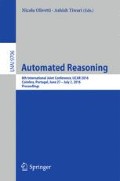Abstract
Schematic cut-elimination is a method of cut-elimination which can handle certain types of inductive proofs. In previous work, an attempt was made to apply the schematic CERES method to a formal proof with an arbitrary number of \(\varPi _{2}\) cuts (a recursive proof encapsulating the infinitary pigeonhole principle). However the derived schematic refutation for the characteristic clause set of the proof could not be expressed in the schematic resolution calculus developed so far. Without this formalization a Herbrand system cannot be algorithmically extracted. In this work, we provide a restriction of infinitary pigeonhole principle, the ECA-schema (Eventually Constant Assertion), or ordered infinitary pigeonhole principle, whose analysis can be completely carried out in the existing framework of schematic CERES. This is the first time the framework is used for proof analysis. From the refutation of the clause set and a substitution schema we construct a Herbrand system.
Access this chapter
Tax calculation will be finalised at checkout
Purchases are for personal use only
References
Baaz, M., Hetzl, S., Leitsch, A., Richter, C., Spohr, H.: Ceres: An analysis of Fürstenberg’s proof of the infinity of primes. Theoret. Comput. Sci. 403(2–3), 160–175 (2008)
Baaz, M., Leitsch, A.: On skolemization and proof complexity. Fundamenta Informaticae 20(4), 353–379 (1994)
Baaz, M., Leitsch, A.: Cut-elimination and redundancy-elimination by resolution. J. Symbolic Comput. 29, 149–176 (2000)
Baaz, M., Leitsch, A.: Methods of Cut-Elimination. Springer Publishing Company, Incorporated (2013)
Brotherston, J.: Cyclic proofs for first-order logic with inductive definitions. In: Beckert, B. (ed.) TABLEAUX 2005. LNCS (LNAI), vol. 3702, pp. 78–92. Springer, Heidelberg (2005)
Brotherston, J., Simpson, A.: Sequent calculi for induction and infinite descent. J. Logic Comput. 22, 1177–1216 (2010)
Bundy, A.: The automation of proof by mathematical induction. In: Robinson, J.A., Voronkov, A. (eds.) Handbook of Automated Reasoning, pp. 845–911. Elsevier, Amsterdam (2001)
Cerna, D., Leitsch, A.: Analysis of clause set schema aided by automated theorem proving: Acase study (2015). arXiv:1503.08551v1 [cs.LO]
Cerna, D., Leitsch, A.: Schematic cut elimination and the ordered pigeonhole principle [extended version] (2016). arXiv:1601.06548 [math.LO]
Cerna, D.M.: Advances in schematic cut elimination. Ph.D. thesis, Technical University of Vienna (2015). http://media.obvsg.at/p-AC12246421-2001
Comon, H.: Inductionless induction. In: Robinson, A., Voronkov, A. (eds.) Handbook of Automated Reasoning, pp. 913–962. Elsevier, Amsterdam (2001)
Dunchev, C.: Automation of cut-elimination in proof schemata. Ph.D. thesis, Technical University of Vienna (2012)
Dunchev, C., Leitsch, A., Rukhaia, M., Weller, D.: Cut-elimination and proof schemata. In: Aher, M., Hole, D., Jeřábek, E., Kupke, C. (eds.) TbiLLC 2013. LNCS, vol. 8984, pp. 117–136. Springer, Heidelberg (2015)
Gentzen, G.: Untersuchungen über das logische Schließen I. Math. Z. 39(1), 176–210 (1935)
Girard, J.-Y.: Proof Theory and Logical Complexity. Studies in Proof Theory, vol. 1. Bibliopolis, Naples (1987)
Mcdowell, R., Miller, D.: Cut-elimination for a logic with definitions and induction. Theoret. Comput. Sci. 232, 2000 (1997)
Takeuti, G.: Proof Theory. Studies in Logic and the Foundations of Mathematics, vol. 81. American Elsevier Pub., New York (1975)
Weidenbach, C., Dimova, D., Fietzke, A., Kumar, R., Suda, M., Wischnewski, P.: SPASS version 3.5. In: Schmidt, R.A. (ed.) CADE-22. LNCS, vol. 5663, pp. 140–145. Springer, Heidelberg (2009)
Author information
Authors and Affiliations
Corresponding author
Editor information
Editors and Affiliations
Rights and permissions
Copyright information
© 2016 Springer International Publishing Switzerland
About this paper
Cite this paper
Cerna, D.M., Leitsch, A. (2016). Schematic Cut Elimination and the Ordered Pigeonhole Principle . In: Olivetti, N., Tiwari, A. (eds) Automated Reasoning. IJCAR 2016. Lecture Notes in Computer Science(), vol 9706. Springer, Cham. https://doi.org/10.1007/978-3-319-40229-1_17
Download citation
DOI: https://doi.org/10.1007/978-3-319-40229-1_17
Published:
Publisher Name: Springer, Cham
Print ISBN: 978-3-319-40228-4
Online ISBN: 978-3-319-40229-1
eBook Packages: Computer ScienceComputer Science (R0)

